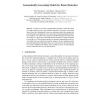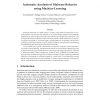23 search results - page 3 / 5 » Detecting the Onset of Infection for Secure Hosts |
CCS
2003
ACM
13 years 10 months ago
2003
ACM
After the Code Red incident in 2001 and the SQL Slammer in January 2003, it is clear that a simple self-propagating worm can quickly spread across the Internet, infects most vulne...
ESORICS
2009
Springer
14 years 5 months ago
2009
Springer
A botnet is a network of compromised hosts that is under the control of a single, malicious entity, often called the botmaster. We present a system that aims to detect bots, indepe...
CN
2007
13 years 4 months ago
2007
Worms are self-replicating malicious programs that represent a major security threat for the Internet, as they can infect and damage a large number of vulnerable hosts at timescal...
JCS
2011
12 years 7 months ago
2011
Malicious software—so called malware—poses a major threat to the security of computer systems. The amount and diversity of its variants render classic security defenses ineffe...
INFOCOM
2003
IEEE
13 years 10 months ago
2003
IEEE
— It has been clear since 1988 that self-propagating code can quickly spread across a network by exploiting homogeneous security vulnerabilities. However, the last few years have...


